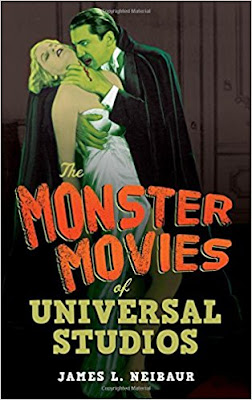Review: Monsters of a Universal kind
THE MOVIE MONSTERS OF UNIVERSAL STUDIOS, by James L. Neibaur. Lanham, Md.: Rowman & Littlefield, 2017, 213 pages. $38 (hardcover), $36 (e-book).
 While the field of book-length studies of the iconic monster films produced by Universal Pictures between the 1930s and '50s is a crowded one, James L. Neibaur proves there's always room for one more with a fresh viewpoint and solid observations about what makes those flicks great and what doesn't. THE MONSTER MOVIES OF UNIVERSAL STUDIOS is written with the assurance of a devotee, but one who can view them dispassionately and be unafraid of calling them out on their defects -- not there are that many, in this reviewer's humble opinion.
While the field of book-length studies of the iconic monster films produced by Universal Pictures between the 1930s and '50s is a crowded one, James L. Neibaur proves there's always room for one more with a fresh viewpoint and solid observations about what makes those flicks great and what doesn't. THE MONSTER MOVIES OF UNIVERSAL STUDIOS is written with the assurance of a devotee, but one who can view them dispassionately and be unafraid of calling them out on their defects -- not there are that many, in this reviewer's humble opinion."The monster movies ... have extended beyond the context of the era of their release and have lived on over time and generations," Neibaur rightly contends in explaining the book's thesis when it comes to the Universal classics. "The iconic characters and enduring stories continue to resonate."
The book begins as expected with the studio's first sound foray into monster territory, 1931's DRACULA, but extends its overview beyond ABBOTT & COSTELLO MEET FRANKENSTEIN (1948) -- where many studies end or fail to include -- to the Creature from the Black Lagoon movies that represented Universal's last gasp at creating a new monster to serve audiences in an era where science fiction supplanted gothic horror. That is, until later in the '50s when Great Britain's Hammer Films once more made Dracula and Frankenstein all the rage.
It is the inclusion of the Creature films of 1954-1956 that make the book unique, with the author working hard and successfully at convincing his readers that they were as much fright films with a distinctive type of monster as they were SF thrillers. More often, the Creature movies have been treated as a special case by historians, while classic monsters' appearances in the Abbott & Costello comedies ...MEET THE INVISIBLE MAN (1951) and ...MEET THE MUMMY (1955) are dismissed because these cinematic bogeymen were included in burlesques to bolster the career of the longtime comic team. These movies are included in THE MOVIE MONSTERS OF UNIVERSAL STUDIOS because they were extensions of the classic beings created in the '30s, Neibaur maintains while providing each the full treatment in plot outline and critical discussion.
One can be expected to disagree with Neibaur on some points because each fan has their own likes and dislikes. Case in point, his analysis of WEREWOLF OF LONDON (1935) as a misfire in light of THE WOLF MAN, which hit screens six years later. THE WOLF MAN remains a great movie for many reasons, but was very much a product of the "new" Universal that replaced the regime of studio founder Carl Laemmle Sr. and his son, production chief Carl Jr., in the mid-'30s. THE WOLF MAN, like other Universal product of its time, is fast and compact, a mixture of mood and action. WEREWOLF OF LONDON is more representative of the Laemmle days, heavy on atmosphere if slow in pacing, but unforgettable once seen. But to each his own.
In fact, the only quibble to be had with THE MONSTER MOVIES OF UNIVERSAL STUDIOS is that it needed a good proofreader (and who doesn't?) before going into print. But Neibaur, a film historian with a number of books to his credit (with one forthcoming on the Charlie Chan movies of the 1930s and '40s), is to be forgiven as he informed Facebook friends of difficulties encountered in completing the volume that may have prevented a thorough once-over before publication. Still, don't allow any of that to deter you from enjoyment of the book and Neibaur's informed commentary on the films built around Dracula, the Frankenstein monster, the Mummy, the Invisible Man, the Wolf Man and the Creature.
As advertised in its title, Neibaur's work does not discuss other famous Universals as THE BLACK CAT (1934) or THE RAVEN (1935) because its "monsters" were all too human, not a product of the supernatural, scientific error or a throwback to ancient times. Perhaps a look at thrillers such as Bela Lugosi's MURDERS IN THE RUE MORGUE (1932) or one-offs like MAN-MADE MONSTER (1941) with Lon Chaney Jr., not to mention the studio's early '50s attempts at gothic terror in THE STRANGE DOOR and THE BLACK CASTLE, is in the works. If produced, such a piece of scholarship would be just as welcome as Neibaur's page-turner of a study as we now possess. -- Kevin Kelly.



Comments
Post a Comment